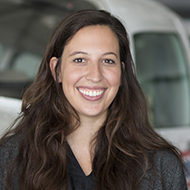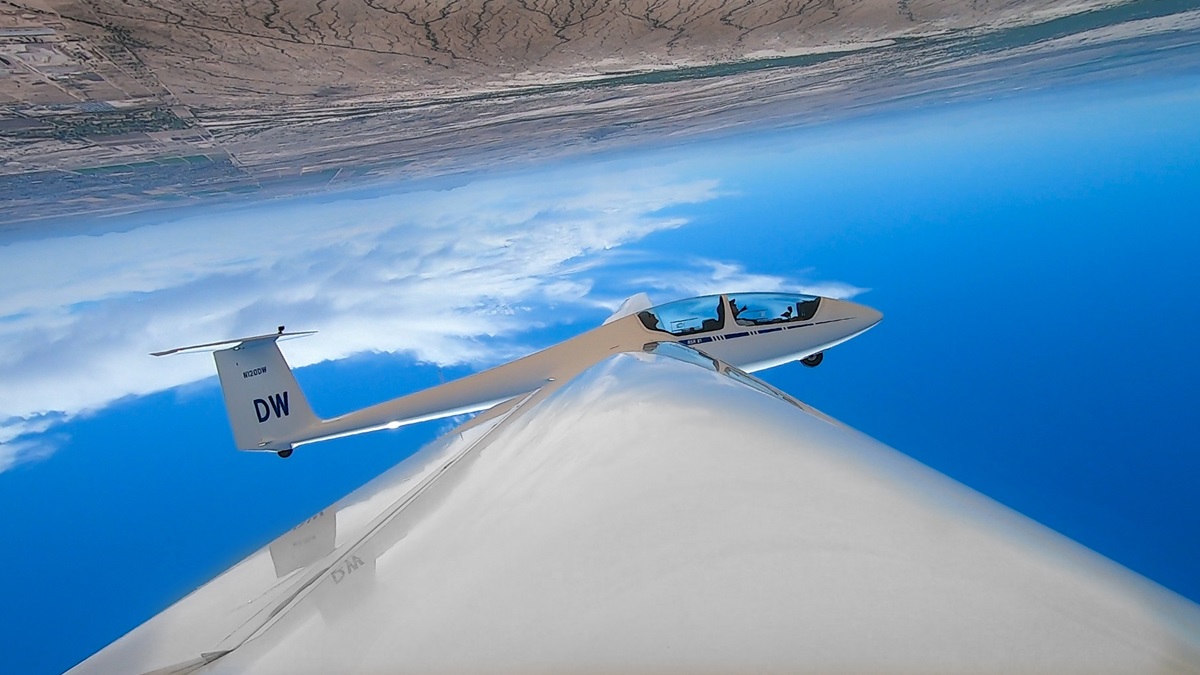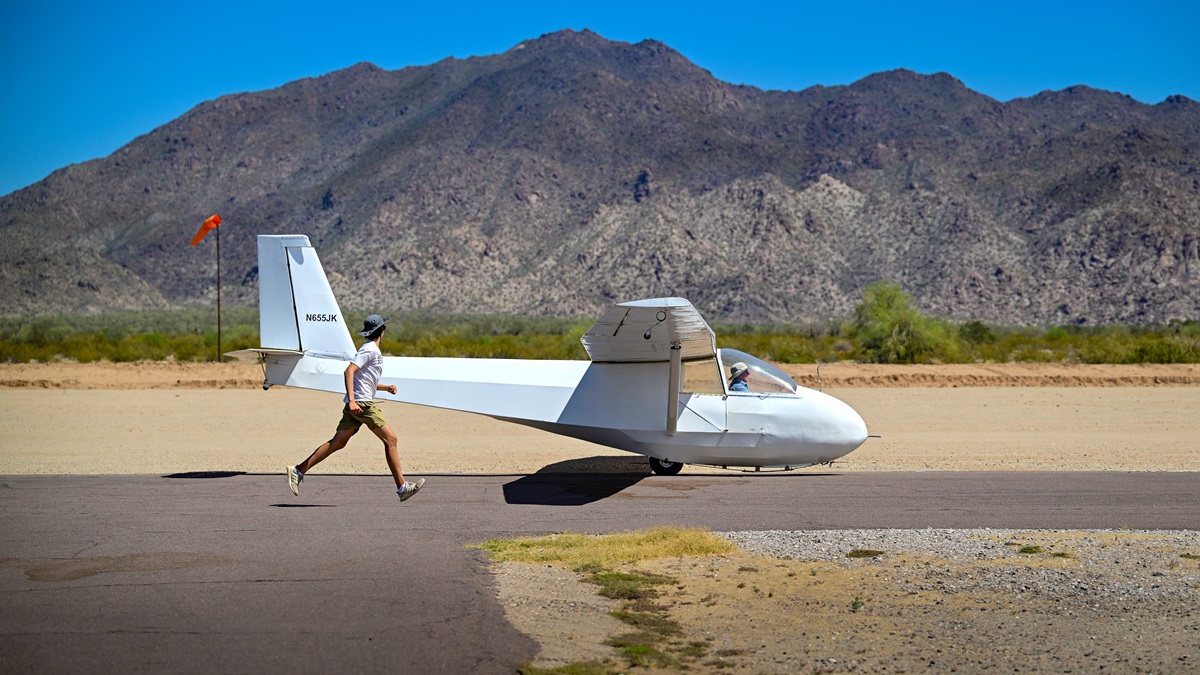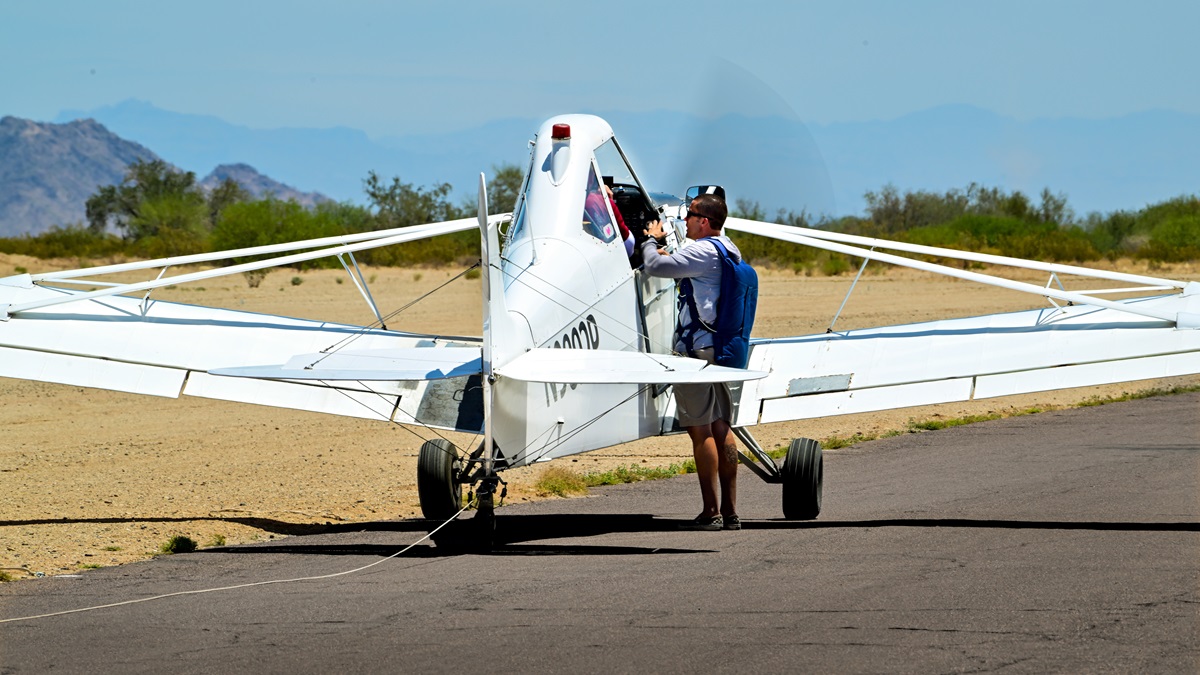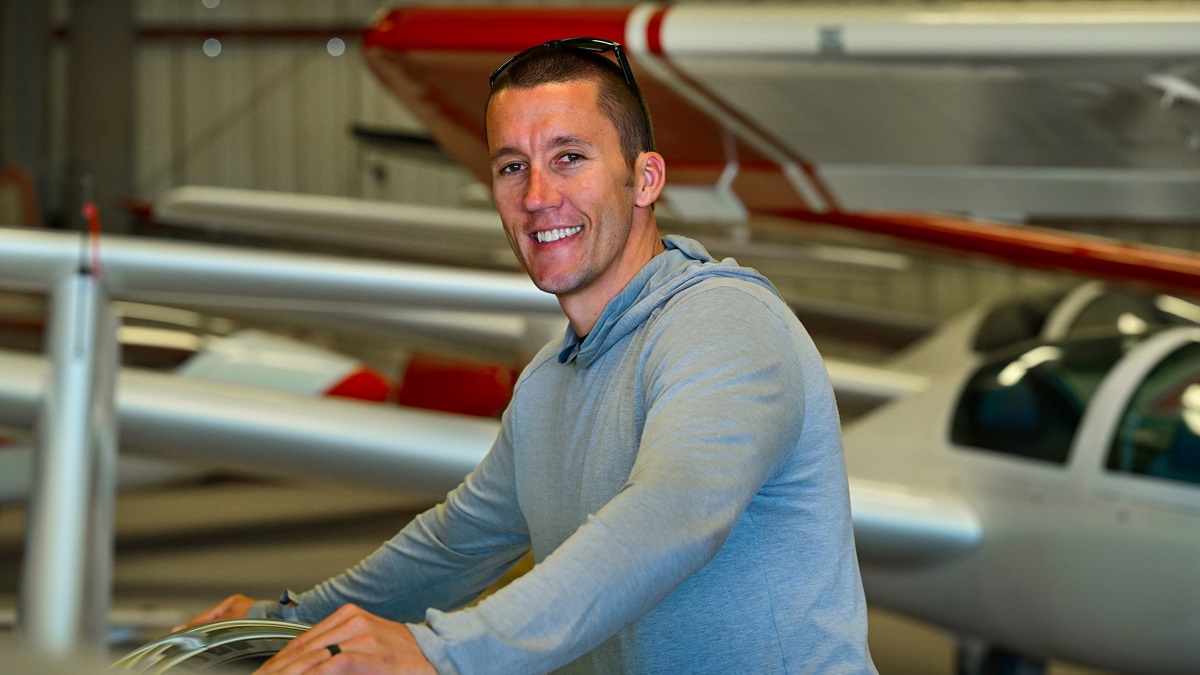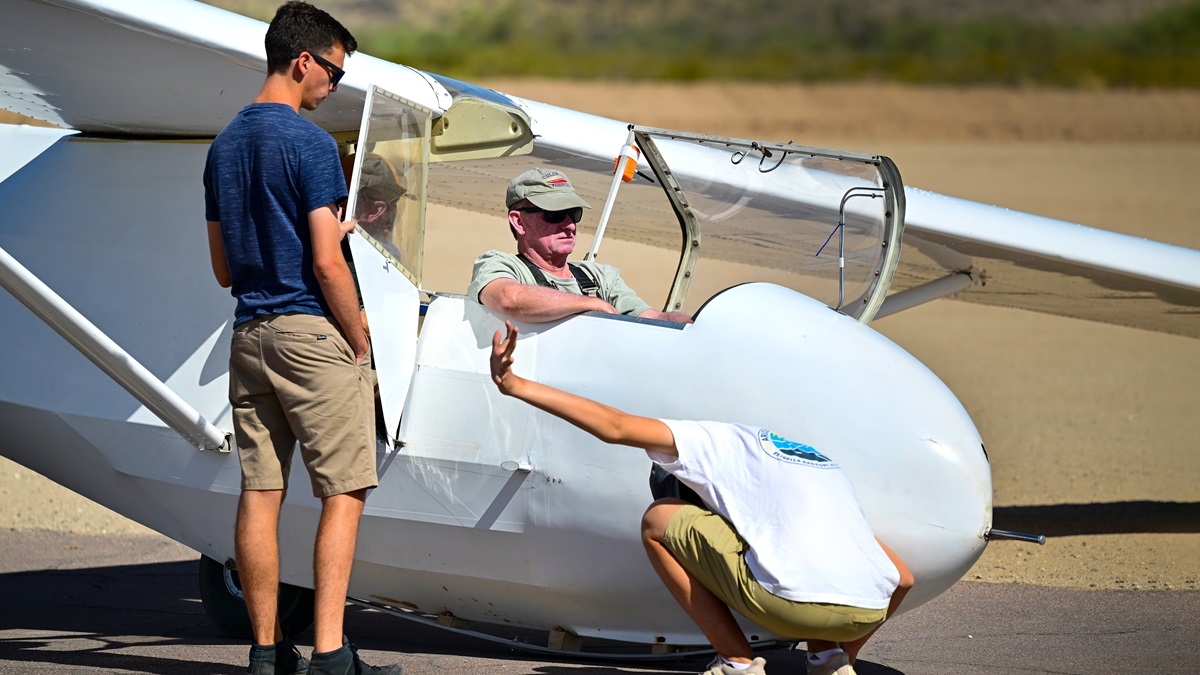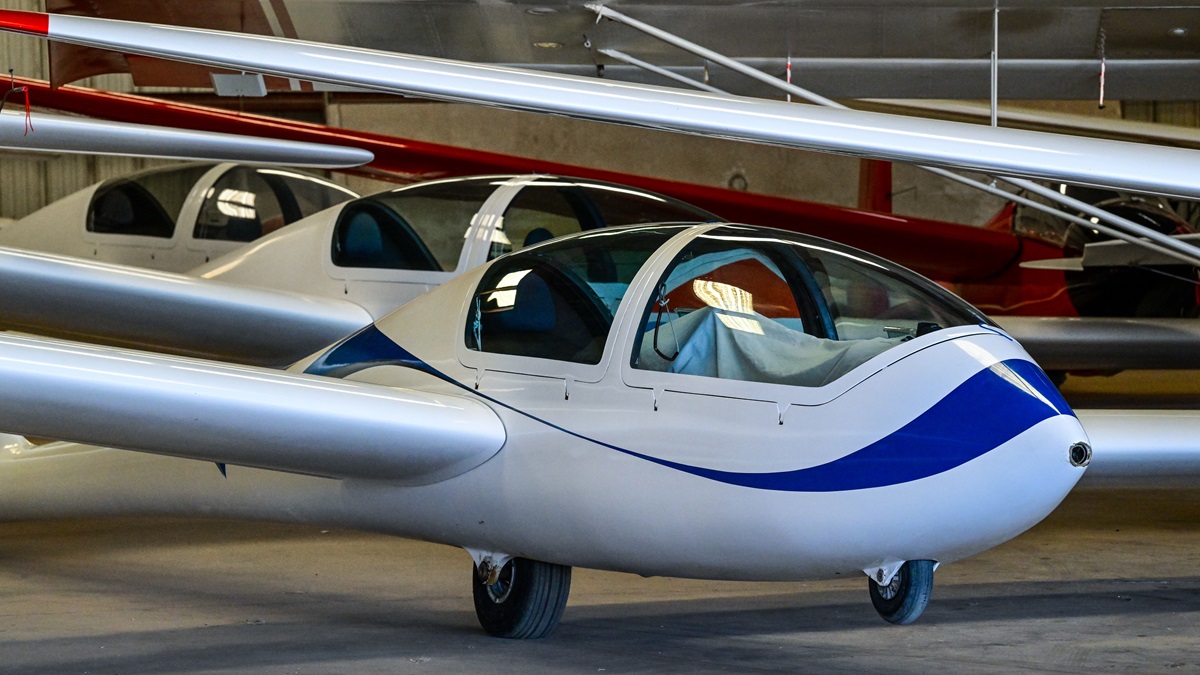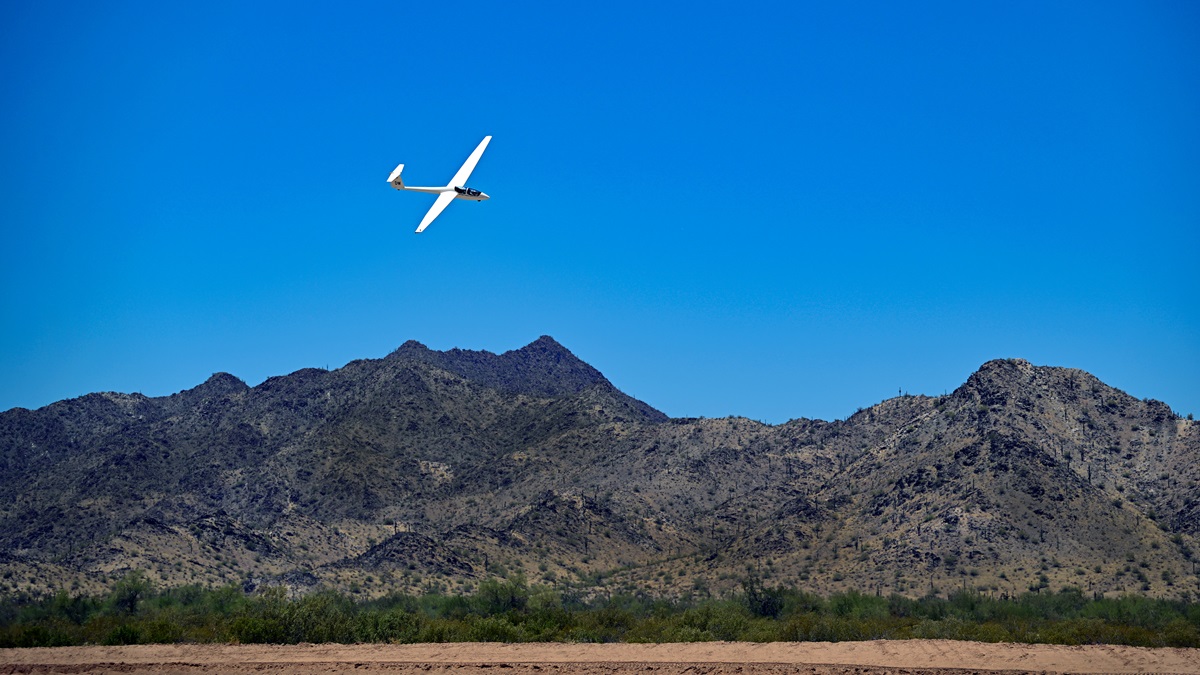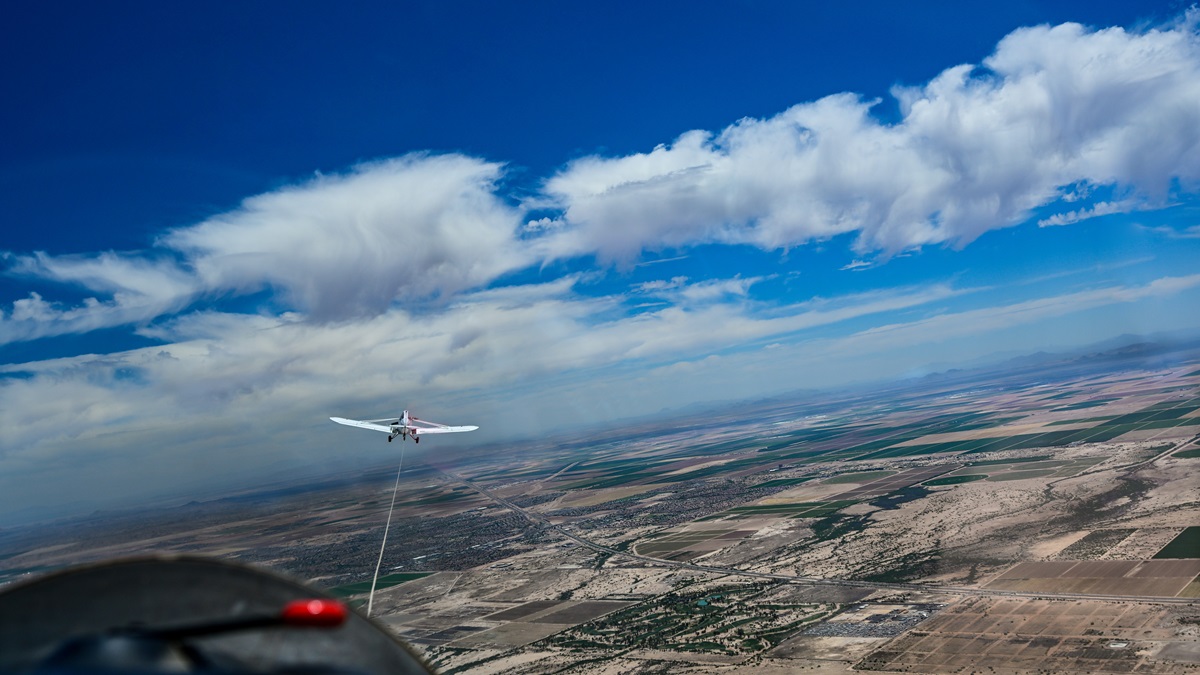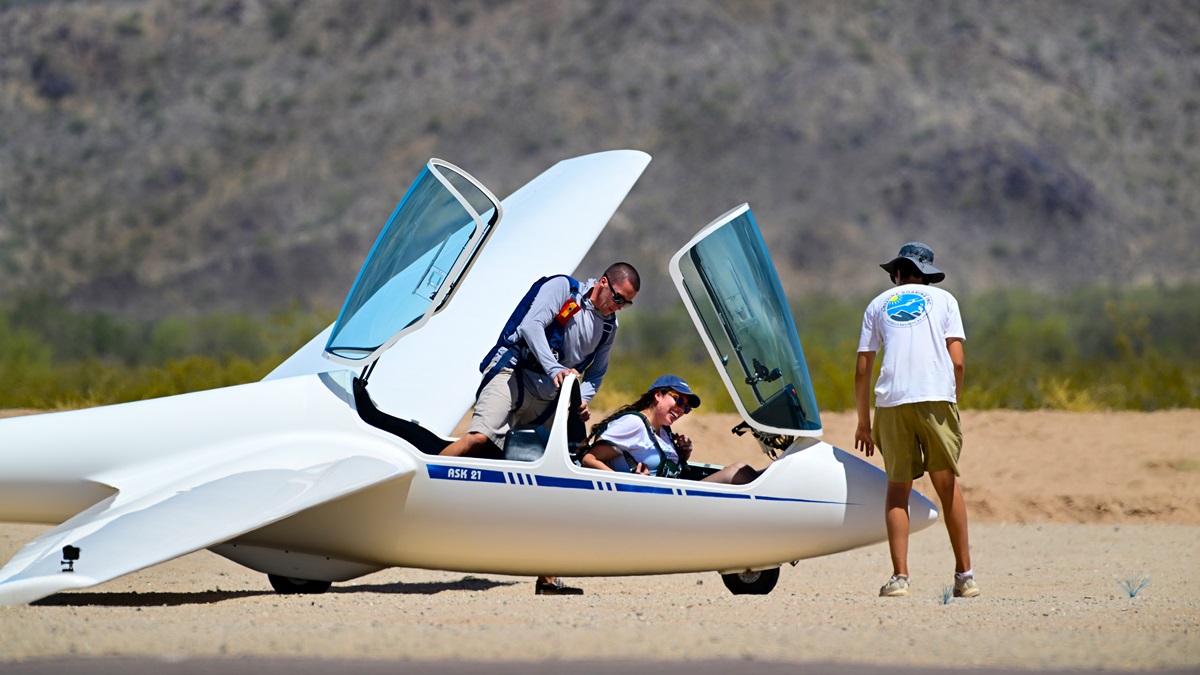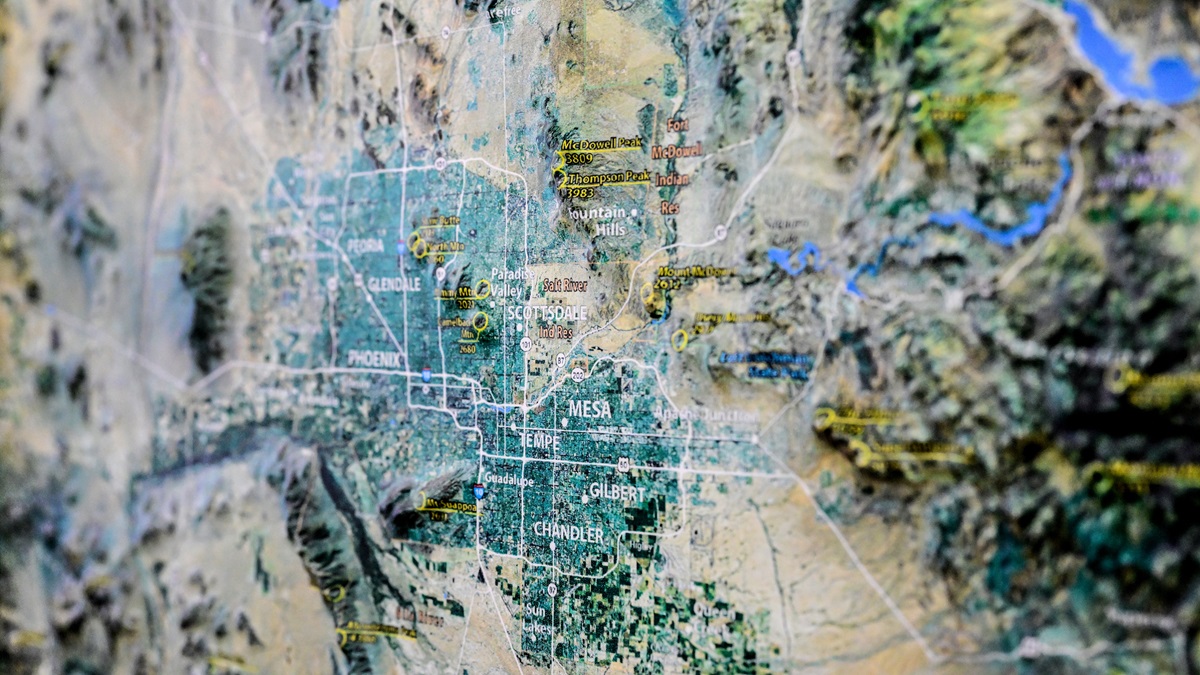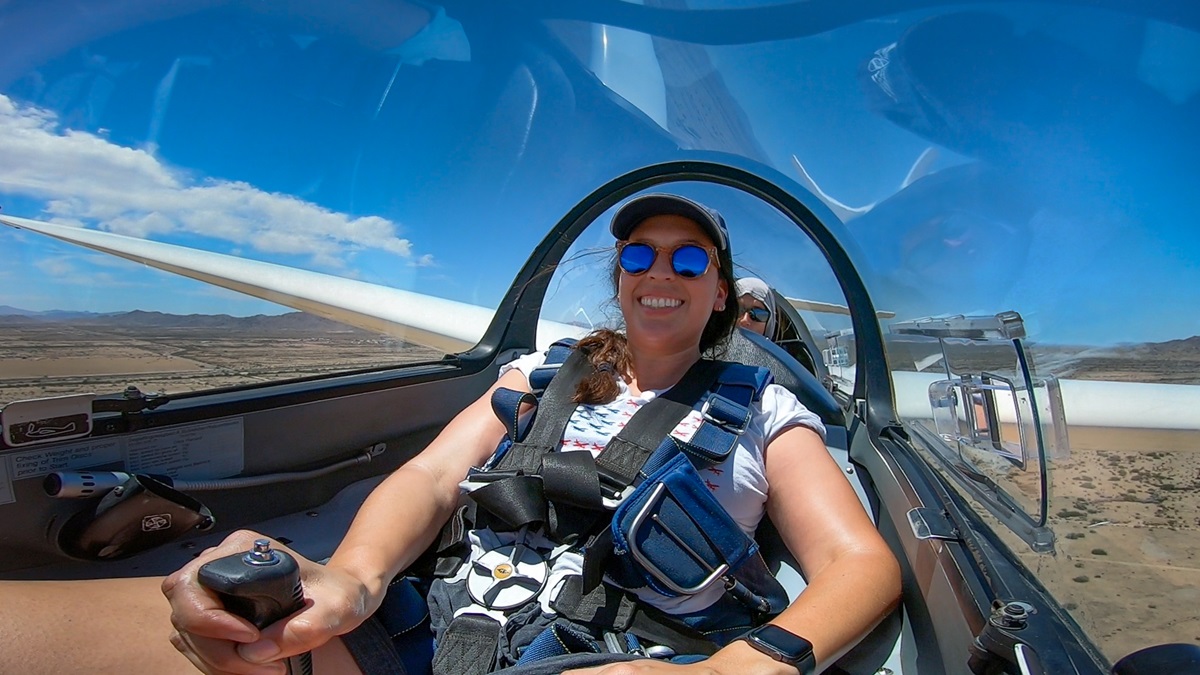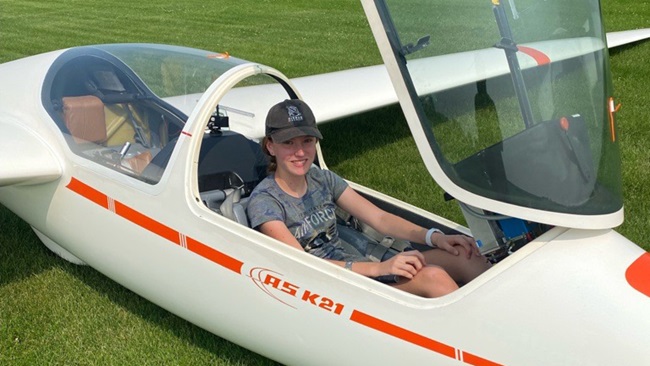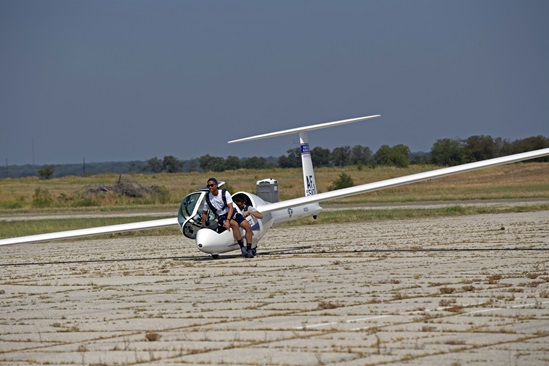Sonoran soaring
Glider aerobatics over the Arizona desert
The trademark Arizona sun is already intense, and dust devils dance across the cracked earth where only tumbleweeds, saguaros, and the most resilient of desert life survives. All that hot, rising air makes the area perfectly suited for one thing: flying gliders.
We’re here to fly with Shad Coulson, operations manager of Arizona Soaring, glider CFI, and competitive glider aerobatic pilot. Today I’m hoping to get a taste of both the basics of straight-and-level flying and some intro aerobatics. But mostly, I’m just excited to see what glider flying is like. Is it really the “purest” form of flying, as the hardcore sailplane pilots preach?
Coulson greets us in the air-conditioned office, and we walk toward the runway together. AZ Soaring has a spacious hangar, with glider after glider carefully Tetrised in and a few lifted above. Coulson takes us on a tour and we climb over, under, and around long, thin wings. He points out purely aerobatic gliders, sleek as can be, the bulkier trainers, and a lone Aviat Husky that’s the back-up towplane. One of the single-seat gliders we look at is under 500 pounds—less than a Harley Sportster or a Triumph Bonneville motorcycle. Sailplane pilots, he tells me, are obsessed with weight and drag, and he also points out tape covering the gaps of control surfaces to reduce drag just that little bit more.
Coulson tells us the soaring school doesn’t have a typical student. They train all sorts in Maricopa, from young teens looking for an adventure (you can solo a glider at 14) to multi-thousand-hour airline pilots and curious powered-GA pilots. They even conduct some U.S. Air Force training, and despite the heat they are open year-round.
“Most people visit in the winter,” he says.
We weave our way back to the front of the hangar to watch launches and landings. It’s instantly clear that gliding is a team effort. First, we see a landing—someone on their third solo. As soon as the glider touches down and comes to a stop, one wing tipping down to Earth, anyone available scurries out to the aircraft to help the pilot wheel the glider back toward the hangar.
For the launch, the gliders are towed to altitude by a single-seat Piper Pawnee. First, the Pawnee lines up ahead of the glider, and then the tow rope is attached. Using hand signals and checking a rear-view mirror, the ground crew, glider pilot, and tow pilot communicate how high to tow the glider. And then, once everything is set, the glider pilot indicates with a wave of the flight controls and a thumbs up that they’re ready to go.
The Pawnee begins the takeoff roll and the rope pulls taut. The ground crew runs along the side of the wing as the glider gets going to make sure the wings don’t hit the ground. Within just a couple hundred feet, the glider is off the ground—well before the airplane is wheels up. Then the aircraft rotates and the climb begins. This process is quick, smooth, and fascinating to watch. For so much activity, it’s quiet, and the only sound is the engine of the Pawnee.
Same, same, but different
Most of the tows we watch are of the Schweizer SGS 2-33, what Coulson says is essentially the Cessna 150 of the glider world. These high-wing, solid-looking aircraft are stable, forgiving, and easy to learn in, he tells me. The glider we’ll be flying is a Schleicher ASK 21, and it is what I had pictured when I imagined glider flying. It’s clean, narrow-bodied, and low-winged, and it looks like it won’t struggle to go upside down. Our plan is to get an aero tow up to altitude, then I’ll see what it’s like to fly a glider before Coulson takes over the controls for some aerobatics.
Is it really the “purest” form of flying, as the hardcore sailplane pilots preach?We push the ASK 21 out to the runway and get in line for a tow. Parachutes and a layer of sunscreen are all the gear we need—we don’t need headsets, since it’ll be quiet enough to talk to each other, and there’s no room for a flight bag. In fact, now that I’m actually getting in, it doesn’t look like there’s even room for two pilots, especially not me at 5-foot-11 and Coulson who is taller than I am.
“Yeah, you wear a glider,” he tells me as I gingerly step into the front seat and get situated. I’m almost lying down, and my knees still hit the front panel. I feel confined, hot, and uncomfortable, and I briefly wonder how good of an idea this is. The seats are fixed, but Coulson adjusts my rudder pedals so I have a hair more room. He climbs in the back with no problem. Tyler Byron, a high schooler who already is a glider pilot, is leading the ground crew, and he closes the canopy for us. Locked down, it’s probably just a couple inches (if that) above my head. No kidding you wear a glider. This couldn’t be a cozier fit.
The dance begins. Hand signals, wave of the controls, thumbs up to Byron, and we’re off. My hands tightly grasp my knees to deter my instincts to reach for the controls. We’re off the ground in seconds, and micro control inputs from Coulson keep us in the perfect spot behind the Pawnee. Once the Pawnee rotates, we start the climb.
Falling with style
We’re towed up to 5,000 feet, where the Pawnee levels off. Coulson pulls the release, and we turn away from each other. Now that we’re free of the aero tow, it feels the same as a powered airplane, but different. Same control inputs to get what you want, same seat-of-the-pants feeling, but the sensory difference of the relative silence plus the clear view ahead is astounding and beautiful. The Sonoran Desert reaches as far as the eye can see, and its burnt sienna brown contrasts with the sky in a way that makes it look an even deeper blue than normal. The wings are longer and the visibility is different, but the controls feel pretty much the same. I’m not perfectly coordinated, and I’m not used to the slightly nose-low sight picture, but even so, we’re barely descending, which surprises me.
The biggest worry I have as a powered airplane pilot is what we would do if we couldn’t make it back to the airport, but this is not as big a concern in glider flying as I’d expected. Coulson says it comes down to situational awareness. These gliders have a 1:32 glide ratio, so if you get yourself that far away from an airport and lose that much situational awareness, he says, that’s on you.
I fly a few more minutes before we reach the aerobatic box, and Coulson briefs me on the extra fun part of the flight. He tells me we’ll start with a loop and then keep the ball rolling and go from one maneuver to the next.
“You ready?”
“I’m ready.”
He noses us over and the wind whips around us, getting louder and louder before we pull up. Eyes outside—look at the wing—eyes ahead and wow! We’re upside down!
Briefly weightless at the top of the loop, looking out that huge clear canopy that gives a full 360-degree view, I feel like an astronaut. We’re floating, and everything is so clear, quiet, and peaceful. There’s no engine sound, no wind sound, no smell of fuel. There’s only the view, and the limitless, open sky. The glider no longer feels confining—it feels like the perfect fit. This is real flying.
Coulson expertly manages our energy as we move from one maneuver to the next, smooth as can be and barely losing any altitude in the process. This level of aircraft control doesn’t happen overnight. After using up all the energy we can, we get ready for a landing. This is the only inconvenience of sailing—I’m not ready for the flight to be over, and an engine sure would be helpful to just climb up and do it all again right now.
You only get one chance to land, of course, but Coulson is so in tune with the machine that he does a low pass first, reenters the pattern, and lands without breaking a sweat.
While the flying was essentially the same as in an airplane, the landing feels very different. We aim to touch down in between two narrow lines (barely wider than the fuselage) in the dirt. We’re so low to the ground, which also feels wrong, and as the wheels touch, the screeching of the tires begins, and we rather quickly but smoothly come to a stop. After such a quiet flight, the racket of returning to Earth is jarring.
The crew runs out to greet us as we pop the canopy open and climb out. I forgot about the heat while aloft, but now that we’re back on the ground it feels like we just opened an oven. We swing the glider’s wings around and push it back to the hangar. It’s afternoon now, and pilots are milling about and waiting for that rising air to rise even more. With enough thermals, they tell me, they’ll only have to pay for a tow to a couple thousand feet instead of higher, and they’ll still be able to stay in the air for hours. You sweat more, sure, but you save money and fly for longer. Turns out that for sailplane pilots, “just right” means boiling hot.
We take a few minutes’ break on the ground and then go back up for another flight. The wind has been light but fickle all day and the team looks to Byron to decide if they’ll switch tow directions; he decides we will.
This time, I get to do the takeoff. I wave our rudder, give Byron the thumbs up, and Coulson coaches me. It all feels like it is happening faster than I can take in and my shoulders tense up. A little back-pressure to get us off the ground, dancing taildragging feet to keep us lined up, and laser focus on the Pawnee ahead of us. The glider wants to fly, so getting it off the ground is no big deal, and at the controls, it feels like a pretty normal takeoff. Flying during the tow, however, is something else.
I follow Coulson’s instruction and try to mirror the Pawnee’s control inputs, bank for bank and pitch for pitch, all while keeping the Pawnee’s wheels approximately on the horizon. We’re going back up to 5,000 feet, and as far as I can tell the world consists of only the Pawnee and the six feet either side of it. I am completely tunnel visioned on the tow, and I have to snap myself out of it to look at the sailport and keep my bearings. It feels at least as complex as hard IFR, and I can’t remember the last time I had to focus so much in the air.
When I get low, we get into the Pawnee’s wake and I mentally apologize to the tow pilot. I used to tow banners, and a gusty day with a big banner felt bad enough—I can’t imagine how uncomfortable it is to have a student pilot attached to you. But Coulson tells me I’m doing fine and to keep working it. At last, we reach our target altitude, and this time, I release the tow. With a little nose up to reduce pressure on the tow rope, and a little pop of letting it go, we turn away from the Pawnee and begin sailing.
We fly closer to the mountains, and the air has changed slightly. What was almost perfectly smooth in the morning is bumpy now, and Coulson considers calling off the aerobatic portion of the flight. But once we fly into the aerobatic box, the air is smooth enough and we try it again. After another fun series of maneuvers that I don’t want to end, we call it a day and land the opposite direction as we did before. This time I’m ready for the noise of landing and it feels less alarming.
We climb out, and Tulis gets a chance to fly before we wrap it up, grabbing some T-shirts on the way out and both making plans to come back and add the class to our certificates. The heat at this point is stifling, and just as we’re leaving, the folks who were waiting for the hottest time of the day get their aero tows. I’m happy to wait for cooler weather to try again.
It’s said that gliding is the purest form of aviation, and that in turn it makes the purest aviators. In just a couple short flights, I see why. It hooks you—sucks you in—and it’s great fun. When you only get one chance at the landing, you tend to get it right and pay a little more attention. If you’re looking for the next great challenge, and want to make yourself a better overall pilot, fly sailplanes.
